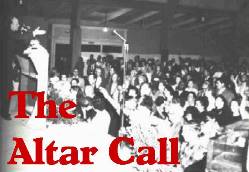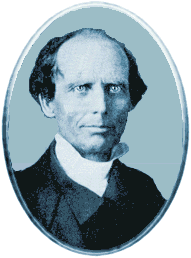 I recently came across two posts which led me to spend some time considering the legacy of Charles Finney.
I recently came across two posts which led me to spend some time considering the legacy of Charles Finney.
First, I read this post by Ryan Debarr: “Depravity and the Altar Call, part one“. Ryan focuses on the altar call (or the invitation) in respect to Christians, not its evangelistic use. I agree with him that the altar call’s emphasis on making decisions may very well harm true Christian growth. Ryan says, “Rarely does a person give up a sin with a one-time act of the will….We should be more honest with people. It is usually not so easy as a mouthing a few words one time.”
Then I came across a post by Captain Headknowledge(aka John Chitty) on Charles Finney. He was celebrating Finney’s 214th birthday! Well, if you read his post, you may not think he is actually “celebrating” the occasion at all.
Now it goes without saying that Finney is lauded in many circles, especially among fundamentalists. He was required reading at my alma mater. While IFBx fundamentalists warn against reading the likes of MacArthur or Piper, they encourage the reading of Finney. Yet Finney is a heretic!
Yes, I said it, a heretic. If you have any doubt read this article by Phil Johnson which documents his heresy in detail. He denied original sin, substitutionary atonement (penal satisfaction), and even justification by faith alone. For proof on the last point I submit the following quote from his own Systematic Theology.
By sanctification being a condition of justification, the following things are intended:
(1.) That present, full, and entire consecration of heart and life to God and His service, is an unalterable condition of present pardon of past sin, and of present acceptance with God. (2.) That the penitent soul remains justified no longer than this full-hearted consecration continues. If he falls from his first love into the spirit of self-pleasing, he falls again into bondage to sin and to the law, is condemned, and must repent and do his “first work,” must turn to Christ, and renew his faith and love, as a condition of his salvation. . . .
Perseverance in faith and obedience, or in consecration to God, is also an unalterable condition of justification, or of pardon and acceptance with God….[1]
 Yet it is not Finney’s theology for which we most remember him today. Indeed most evangelicals have forgotten that he was a heretic. His theology may have influenced some liberals, but it is his methodology which has come to influence almost every sector of evangelicalism today.
Yet it is not Finney’s theology for which we most remember him today. Indeed most evangelicals have forgotten that he was a heretic. His theology may have influenced some liberals, but it is his methodology which has come to influence almost every sector of evangelicalism today.
Finney was known for his “new methods”. He measured the value of methods based on how well they produced results. Thus, pragmatism was the hallmark of his ministry. Some of the methods that he either originated or popularized include “a more dramatic form of preaching”, “public prayer used as a tool for applying pressure to sinners”, protracted evangelistic meetings[2], and the “use of the ‘prayer of faith’and the ‘anxious bench'”[3]. The invitation system as we know it today (also known as the altar call) was popularized by finney in the 1830s. According to Albert Dod a professor at Princeton who was a contemporary critic of Finney, “one will search in vain for a single example of this practice [i.e. the invitation system] before the 1820’s”[4].
This leads us back to thinking about the altar call. Finney had theological reasons for utilizing the altar call. He believed that salvation was dependent on sinners using their will to reform/repent and believe. The methods he used had to be effective in breaking the stubborn will of sinners.[5] So Finney used the altar call to put pressure on people to believe on the spot. And the tactic worked. It produced results. Yetthe results Finney produced (by some accounts as many as 500,000 converts) are contested. Even Finney’s own contemporary supporters recorded that the vast majority of the converts had not remained true to the Christian faith years later.[6]
Today, the altar call continues to be used prominently. And it continues to present inherent problems. I came across another blog post by Tim Irvin from a blog named “If Error is Harmless…Then Truth is Useless” (HT: Thirsty Theologian) which highlights how exactly the altar call can be harmful. Let me provide an excerpt from a quote Timgives by Jim Ehrhard which gets to the crux of the issue.
Here we have one of the greatest dangers of the invitation system. Even those employing it go to great pains to make clear that “going down the aisle” does not save anyone….Billy Graham, for example, says:
“There’s nothing about the mechanics of coming forward that saves anybody’s soul. Coming forward is an open acknowledgment and a testimony of an inward experience that you have had with Christ. But this inward experience with Christ, this encounter, is the most important thing.”
But examination of the invitation used by Graham shows just how confusing the system is. Keep in mind that Graham has already noted that the coming forward is a “testimony of an inward experience that you have had with Christ.” When is the person converted? Why are they coming?
“I’m going to ask you to come forward. Up there – down there – I want you to come. You come right now – quickly. If you are here with friends or relatives, they will wait for you. Don’t let distance keep you from Christ. It’s a long way, but Christ went all the way to the cross because He loved you. Certainly you can come these few steps and give your life to Him….”
At the “altar,” the confusion continues as he addresses those who have come: “You have come tonight to Jesus Christ, you have come to receive Him into your heart….” Which is it? Have they already come to Jesus, or are they coming now to receive Him? Graham continues: “He receives you; He died for you; He says, ‘Thy sins are forgiven.’ You accept that. The past is forgiven, God forgets…. He cannot even see your sins.”…Then he leads them to repeat a prayer known as “the sinner’s prayer.” The question again is obvious: have they been forgiven, or will they be when they pray the prayer?
To make matters worse, many often add so many things to the invitation that one cannot be certain what he is being asked to do. This was especially true in the invitations of Billy Sunday who often exhorted people to “Come on down and take my hand against booze, for Jesus Christ, for your flag.”[7]
From the above quote you can see that the danger of the altar call is its propensity to confuse the responders. Putting people on the spot might very well result in half-converts, or more precisely, converts that aren’t. In Finney’s case the vast majority wilted as the years passed, and I think it is safe to say that such is the case today. Of the numbers that have responded in Graham crusades or in the evangelistic meetings and general preaching of fundamentalists, how many have truly remained? Could the use of the altar call have been a factor in at least some of these cases? I think so. Perhaps even the ritual of the sinner’s prayer (many times it has devolved into a ritual) is to blame. See my post exploring that question here.
In many respects evangelicals and fundamentalists in particular, have become hand-cuffed to this methodology. Can you imagine how else an evangelist could close an evangelistic appeal to Christ? What can one do other than lead people in a prayer or ask them to come forward? Before 1820 no one ever had utilized either of those methods in preaching the gospel. Paul certainly didn’t. Even Charles Spurgeon did not employ this method. He did have an inquiry room, where awakened sinners could go for personal counseling. Yet even he was wary on depending on that scheme too much. He said: “Sometimes shut up that enquiry-room. I have my fears about that institution if it be used in permanence, and as an inevitable part of the services…. If you should ever see that a notion is fashioning itself that there is something to be got in the private room which is not to be had at once in the assembly, or that God is more at that penitent form than elsewhere, aim a blow at that notion at once.”[8]
In closing, I would like to briefly offer Asahel Nettleton as an alternative. He was the last in a long line of well known Calvinist evangelists, and was a contemporary of Finney’s. Ministering in a much smaller geographical region, with fewer people than the large population centers Finney preached in, Asahel still saw thousands of converts. His numbers do not match Finney’s in sheer magnitude, but they tower above Finney’s in another respect. Nettleton’s converts almost never apostasized. He had 95% or better “perseverance rates”.[9] And you know what? He did not use the altar call. I wonder if this is a lesson for us?
———————————————————————–
Footnotes & Resources for Further Research
[1] Charles Finney, Systematic Theology(Minneapolis: Bethany), 372-73; quoted from “A Wolf in Sheep’s Clothing: How Charles Finney’s Theology Ravaged the Evangelical Movement” by Phillip R. Johnson, an online article accessible here.
[2] Rick Nelson, “How Does Doctrine Affect Evangelism? The Divergent Paths of Asahel Nettleton and Charles Finney” Founder’s JournalSummer 1998 Issue 33–available online here; quote is from paragraph just before the “Applications for Contemporary Evangelism” section (HT: Captain Headknowledge).
[3] Tom Browning, “Charles G. Finney: The Architect of Modern Evangelism”, available online here or in a blog post here.
[4] Albert Dod (in his review of Finney’s Lectures on Revival), quoted by Massimo Lorenzini, “The Modern Invitation System Examined”, available online here; quote taken from this blog post by Tim Irvin.
[5] Rick Nelson, Ibid.
[6] Rick Nelson, Ibid, see text where footnotes 19-22 appear.
[7] Jim Ehrhard, “The Dangers of the Invitation System”, available online here; quote taken from this blog post by Tim Irvin.
[8] Ibid.
[9] Rick Nelson, Ibid, see text where footnote 31 appears. Also, Massimo Lorenzini, ibid (see above #4 for bibliographic info).
Background picture for “The Altar Call” above was borrowed from here; and the Finney picture above was adapted from Phil Johnson’s article listed above.
Like this:
Like Loading...

 I recently came across two posts which led me to spend some time considering the legacy of Charles Finney.
I recently came across two posts which led me to spend some time considering the legacy of Charles Finney. Yet it is not Finney’s theology for which we most remember him today. Indeed most evangelicals have forgotten that he was a heretic. His theology may have influenced some liberals, but it is his methodology which has come to influence almost every sector of evangelicalism today.
Yet it is not Finney’s theology for which we most remember him today. Indeed most evangelicals have forgotten that he was a heretic. His theology may have influenced some liberals, but it is his methodology which has come to influence almost every sector of evangelicalism today.
 Gage Browning of
Gage Browning of